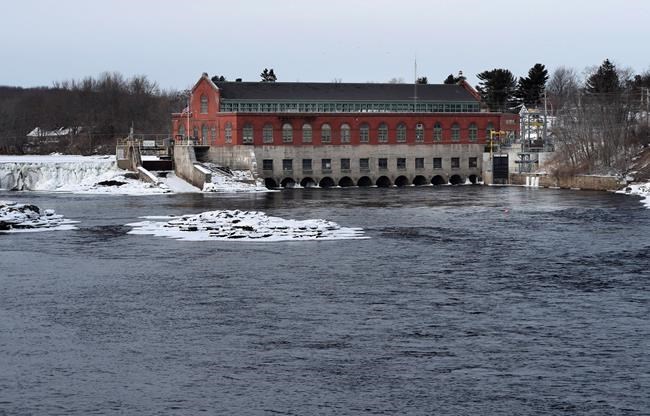
In this Saturday, Jan. 19, 2019 photo, the Brookfield Renewable hydroelectric facility stands at the Milford Dam on the Penobscot River in Milford, Maine. A plan to test the use of a new technology to help endangered Atlantic salmon has been abandoned, at least for now. Brookfield spokesman Andy Davis said the project's architects discovered a "significant risk" to species other than salmon, such as river herring. (AP Photo/Robert F. Bukaty)
January 31, 2019 - 10:05 AM
PORTLAND, Maine - A plan to test the use of a new technology to help endangered salmon in a Maine river that is critical to their existence has been abandoned, at least for now.
Atlantic salmon return to very few rivers in the United States, and the most important of those is the Penobscot River in Maine, which is more than 100 miles (160 kilometres) long and runs inland from the state's mid-coast region.
As the salmon return to rivers from the sea, they are faced with hazards, including manmade structures such as dams.
Fish passages, such as ladder-like structures, are used around the world to help fish around difficult spots so they can eventually spawn. Brookfield Renewable of Toronto had planned to evaluate the performance of a new type of fish passage that might help Maine's salmon navigate a hydroelectric facility the company operates on the Penobscot in Milford, some 140 miles (225 kilometres) north of Portland.
The U.S. Department of Energy awarded the project an $800,000 grant and issued a statement in April signalling its support of the project. But Brookfield spokesman Andy Davis told The Associated Press that the firm has withdrawn from the project, and it's not scheduled to go forward. He said the project's architects discovered a "significant risk" to species other than salmon, such as river herring, from installing the system.
"We found concern about non-targeted species," Davis said. "We're always looking at innovative types of fish passage, and we're hoping that something like this can be implemented on a broad basis."
Davis said the federal money for the project will not be sent due to the cancellation. A U.S. Department of Energy spokesperson confirmed the project isn't moving forward.
The fish passage on the Penobscot was to be a system designed by Whooshh Innovations, a Seattle company. The system would have been designed to use pieces of flexible tube to propel the fish around potential obstacles. Davis said Brookfield is still hoping to use it, and has plans to test it out on alewives at a different location on the Saco River in southern Maine.
Vince Bryan, chief executive officer of Whooshh, said his company is interested in making the Saco River project happen, and he still believes the system could have potential on the Penobscot in the future. He said the system has the ability to more efficiently move salmon and other fish through dangerous areas than older model solutions such as fish ladders and lifts.
"Brookfield was concerned the work would be dangerous. So it would be more expensive than the grant allowed," Bryan said. "What we're trying to organize is a study with alewives."
Alewives are a species of herring.
The Penobscot River is a closely watched body of water in conservation circles because it's the most productive river for the salmon in the U.S. Maine's also the only U.S. state left with native Atlantic salmon populations.
Less than 850 of the salmon returned to the Penobscot in 2017, though the numbers tend to rise and fall from year to year. The number was above 1,000 per year in the late 2000s and early 2010s. The fish are on the U.S.'s endangered species list.
News from © The Associated Press, 2019